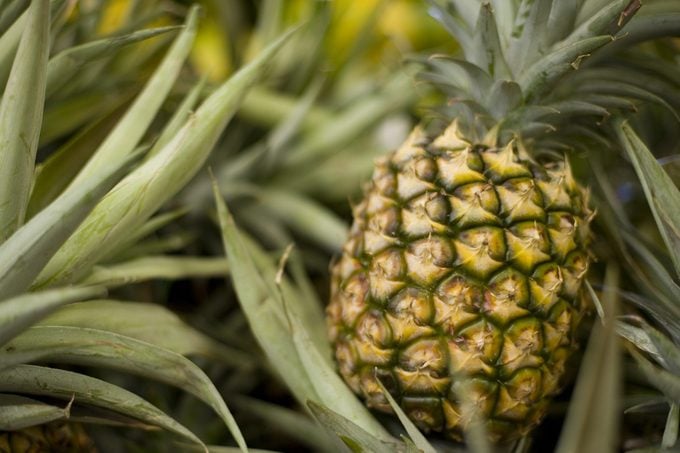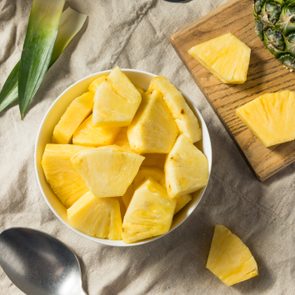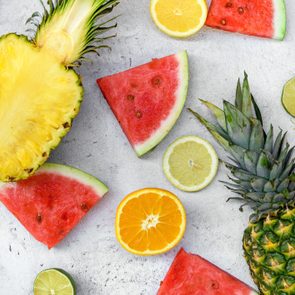8 Benefits of Pineapple That Will Convince You to Eat More
Updated: Aug. 05, 2021
Pineapple is a sweet and tangy fruit packed with numerous health benefits. Learn how pineapple may strengthen your immune system, slow skin aging, and more.
Our editors and experts handpick every product we feature. We may earn a commission from your purchases.
All about pineapple
Pineapple is a culinary gift from nature, sweetening smoothies and salsa and giving us a shot of tangy juice when we bite into a fresh slice. (And, you know, igniting the great Hawaiian pizza debate.)
It may look prickly, what with its rough, spiky skin and pointy green leaves, but there’s a lot to love about this big, yellow-fleshed, tropical fruit.
It’s available year round, whether fresh, frozen, or canned, and is loaded with vitamin C.
Here’s everything you need to know about pineapple’s nutrition, its benefits, and whether or not it’s actually healthy.
Where does pineapple come from?
Despite its name, pineapple isn’t related to pine trees or apples. But when early European colonizers stumbled upon the fruit in South America, they thought it resembled a pine cone and tasted like an apple.
Pineapples don’t grow like pine cones or apples either. Instead of trees, they grow on small shrubs that take a year or two before they’re ready to bear fruit.
“Pineapple grows in the center of a leafy plant,” says Roxana Ehsani, a board-certified sports dietitian and national media spokesperson for the Academy of Nutrition and Dietetics, who’s seen expansive pineapple fields in the French Polynesia islands.
Each plant grows just one pineapple at a time. And it can grow from itself, which means if you plant a pineapple you can grow the fruit.
Or you can easily buy it at the store. The pineapples in American supermarkets probably weren’t grown in the United States. The fruit is typically imported from Central and South America and Mexico, and most come from Costa Rica.
If you find U.S.-grown pineapples, they’re likely from Hawaii or Puerto Rico.

Types of pineapple
You can buy fresh pineapple all year round. But it’s typically considered seasonal in the spring, fall, and winter.
Just like apples have varieties like Granny Smith and Golden Delicious, so do pineapples. Those are less well known, however.
The common pineapple in your supermarket is often in the class called Smooth Cayenne. You might also find a smaller, cuter version called South Africa Baby Pineapple. A few other fun-named varieties include Red Spanish, Queen, Santa Marta, and Kona Sugarloaf.
Beyond fresh, whole pineapple, the tropical fruit is available in various forms, including frozen, canned, dried, dehydrated, preserved, pickled, and juiced.
Your produce department may also prep raw pineapple, taking the trouble out of coring and slicing the fruit.
Are pineapples good for you?
Pineapple has a myriad of health benefits. Though it doesn’t get enough credit, pineapple can be considered a superfruit.
“You may not think of pineapple at first when it comes to fruits rich in vitamin C; however, pineapple is an excellent source of vitamin C,” says Ehsani. “Pineapple is a juicy and refreshing fruit that can help hydrate you and has some unique nutritional features, including bromelain.”
Bromelain is a group of enzymes in a pineapple’s fruit and stem that breaks down protein. (More on bromelain’s benefit in a bit.)
Pineapple nutrition facts
Taste may be your No. 1 motivation for eating for pineapple, but it’s hardly the top reason to reach for the fruit. Pineapple calories are on par with other fruits, and there are plenty of other good-for-you compounds.
Here are key nutrients in 1 cup (165 grams) of fresh pineapple chunks and the percent of recommended daily value (DV) those nutrients meet, based on a 2,000-calorie-per-day eating plan.
Calories: 83
Protein: 0.9 g (2 percent DV)
Fat: 0 g (0 percent DV)
Sodium: 2 mg (0.08 percent DV)
Carbohydrate: 22 g (8 percent DV)
Fiber: 2.3 g (8 percent DV)
Potassium: 206 mg (4 percent DV)
Vitamin C: 79 mg (88 percent DV)
Vitamin B6: 0.19 mg (11 percent DV)
Manganese: 1.53 mg (67 percent DV)
Iron: 0.41 mg (2 percent DV)
Benefits of pineapple
Thanks to all of the vitamins and minerals in pineapple, it can improve your health while it’s amusing your taste buds. Here are some ways eating pineapple may benefit you.
May protect the heart
If you want to keep your ticker healthy, regularly including pineapple in your eating plan may help.
Pineapple is similar to other fruits and veggies in that it is nutrient dense and high in vitamins, minerals, and antioxidants, says Ehsani.
In fact, a recent study published in Nutrition & Metabolism found that eating pineapple daily offered protection against high blood cholesterol levels in rats. That’s good news because high cholesterol is a risk factor for heart disease.
Of course, animal studies like this are very early forms of research and don’t prove definitively that pineapple protects against high cholesterol. More research—on a larger scale and in humans—is necessary.
Also offering potential heart benefits: the enzymes in pineapple.
“Bromelain may help reduce inflammation, a common risk for heart disease,” says Kathy Siegel, RDN, a nutrition consultant and author of The 30-Minute Clean Eating Cookbook.
May reduce cancer risk
To keep cancer away, eating wholesome fruit is always a good idea. That includes pineapple.
“Pineapple contains flavonoids, phenolic acids, and vitamin C—all powerful antioxidants that may help reduce the risk of developing certain diseases and cancer,” says Ehsani.
Animal research published in PLOS One suggests that bromelain may play a helpful role in inhibiting the growth of colorectal cancer cells. Human trials are needed to confirm the findings of this early animal-based research.
While pineapple may not offer therapeutic levels of bromelain, eating the fruit can at least help to protect your cells.
May strengthen the immune system
Though oranges get more love during cold and flu season, pineapple may help boost immunity too.
“Pineapple’s high vitamin C content helps support a healthy and strong immune system,” says Ehsani.
There’s research to support that.
“Consuming vitamin C-rich foods, such as pineapple, may help lower your risk of viral and bacterial infections,” Siegel says. “A study on children in the Journal of Nutrition and Metabolism found that those who consumed pineapple daily reduced their risk of infection or shortened the number of days.”
The mineral manganese is also beneficial for fortifying the immune system. As is bromelain, which has “been linked to helping treat sinusitis and bronchitis,” Ehsani adds.
That’s certainly promising, but more high-quality research is needed to determine bromelain’s effectiveness.
May protect brain health
Bromelain appears to give the brain a boost.
An in vitro study published in Current Alzheimer Research found that bromelain extracted from pineapple stems degraded select molecules associated with Alzheimer’s disease. This suggests a potential use for the enzyme in the prevention and treatment of Alzheimer’s disease.
But don’t celebrate quite so soon. In vitro studies like this are early forms of research, and scientists need to conduct studies in humans to determine if bromelain really does protect against Alzheimer’s disease.
May protect against skin aging
You can’t stop aging, but you can change how aging affects your skin. Perhaps the vitamin C in pineapple can help.
“Along with its important role in immune health, vitamin C may also provide protection against aging skin by limiting the damage induced by UV [ultraviolet] exposure,” says Siegel. “Vitamin C stimulates collagen synthesis and provides antioxidant protection against UV-induced photodamage, which may keep your skin firm and generally looking more vibrant, with fewer wrinkles and less age-related dry skin.”
May reduce arthritis symptoms
Pineapple may have anti-inflammatory properties, making it a good option for people with conditions like arthritis.
We may have the duo of vitamin C and bromelain to thank for its ability to fight inflammation. According to Ehsani, bromelain “has been linked to reducing inflammation,” so it may relieve arthritis symptoms.
Though research is limited, the enzyme seems to be safe and beneficial for reducing swelling, stiffness, and pain associated with arthritis.
May boost digestive health
Since bromelain can break down protein, it may ease digestion. And, Ehsani points out, it’s been linked to diarrhea relief.
There’s a chance it could have an anti-ulcer effect, at least according to a rat study. And the research seems promising regarding bromelain’s beneficial effect on the stomach’s mucous membrane.
Big caveats here, though. A lot of the research on bromelain has been conducted in test tubes and animals. Human studies are still needed before definitively recommending pineapple for diarrhea or gastric ulcer treatment.
And eat with caution if you have gastrointestinal issues. It may make some conditions worse.
“If you struggle with reflux symptoms, tropical fruits such as pineapple may cause discomfort,” says Siegel.
Supports post-workout recovery
Soccer parents like to hand out orange slices after a game. But pineapple chunks work just as well.
“Thanks to pineapple’s anti-inflammatory properties and high vitamin C content, pineapple is the perfect post-workout snack for any athlete,” says Ehsani.
Add pineapple to your daily diet to support recovery after a workout, suggests Siegel. “[Bromelain] may reduce inflammation, fatigue, and soreness in aching muscles,” she says.
Ehsani says there’s another reason athletes ought to reach for the fruit: endurance athletes and those training at high intensities are more susceptible to upper respiratory infections, which you can help ward off by eating vitamin C-rich foods like pineapple.
It’s thirst-quenching too. “Pineapple is comprised of 87 percent water, which can help hydrate any athlete post-workout,” says Ehsani.
Risks or side effects
The benefits of eating pineapple outweigh the risks. Still, there are situations where you might need to be cautious.
Medication interactions
If you take medication, the things you eat or drink may interact it. The bromelain in pineapple, for instance, may “interfere with antidepressants and anticonvulsants,” says Siegel.
When you get a prescription for a medication, ask your doctor or pharmacist if there are any foods or drinks that can affect how it works.
“It’s always best to consult with your health care provider if you’re on certain medications that may interact with certain foods like pineapple,” Ehsani says.
Fruit intake for diabetes
Fruit, including pineapple, contains high amounts of natural sugar.
That leads many people with (or at risk for) diabetes to think it should be limited, but that’s not the case. People with diabetes can eat pineapple.
What’s more, a recent study published in the Korean Journal of Family Medicine found that eating seven ounces of fruit, in general, each day seemed to prevent type 2 diabetes. Sugar-sweetened fruit and fruit juices, on the other hand, may do the opposite.
If you have diabetes, a dietitian can provide guidance on how to account for pineapple’s carbs and include the fruit in your eating plan.
Allergies
Pineapple isn’t a top nine allergen in the United States. But it can cause adverse reactions for some people.
These include irritation (burning or soreness) in your mouth due to pineapple’s bromelain content and acidic pH; oral allergy syndrome (itching or swelling); and, in rare cases, anaphylaxis (wheezing or the inability to breathe).
If you experience any reaction upon eating pineapple, avoidance may be the best strategy. Also know that mild irritation may be curbed by sprinkling pineapple with salt, enjoying it with a dairy product, or eating it warm.
Seek the advice of an allergist if you think you have a pineapple allergy.

How to shop for pineapple
Once picked, pineapple doesn’t keep ripening. So buy one that’s heavy for its size and firm but not rock hard. The leaves should look fresh and green.
And give it a sniff. “The best way to find a ripe pineapple is to sniff the base of a pineapple for a sweet smell,” says Siegel. “Your pineapple may soften, but it will not sweeten after it’s picked.”
Not a huge fan of pineapple’s tang? Try a pink pineapple, Ehsani suggests. “People who have tried it are reporting it to be less sour than yellow pineapples,” she says.
If you can’t find one in stores, you can order pink pineapple online from Melissa’s.
How to prepare pineapple
Beyond the health benefits of eating pineapple, it’s a joy to the palate.
You can generally refrigerate pineapple for up to a week. For the softest, juiciest pineapple, keep it on your counter for a couple days before serving.
To get to the good stuff, cut off the crown and bottom, then slice off the skin following the pineapple shape. Then cut as you wish, such as slicing lengthwise into quarters or crosswise into slices.
More of the pineapple is edible than you may realize. You can pickle the core (yep, it’s 100 percent edible) or simply grate it into salads.
Compost inedible pineapple parts so they don’t wind up in a landfill.
How to eat pineapple
You can eat it as is, of course. But pineapple is tasty in meals as well.
“Pineapple is a versatile fruit that can easily be added to many dishes, sweet or savory, with fibrous flesh that holds up well when cooked,” says Siegel. “Pineapple pairs well with cilantro and lime in tacos; with black beans and cucumbers in a salsa; or honey, mint, and yogurt in a parfait.”
Ehsani enjoys pineapple’s versatility too. “Eat it raw, throw it in a smoothie or smoothie bowl, add it to salad or coleslaw, try it grilled or roasted, or add it to a savory dish for sweet and savory flavors,” she says.
Pineapple can tenderize meat, especially tough cuts, so use it in a marinade.
Pineapple recipes
Embrace pineapple’s sweet side, tossing it in a delicious fruit salad or grilling it for dessert.
Don’t forget about piña coladas. Or cool off with Siegel’s lovely pineapple-coconut ice pops and Ehsani’s favorite tropical green smoothie.
For dinnertime intrigue, explore its savory side in my pineapple-cucumber salsa. Toss pineapple into leafy salads. Pair it with beets or carrots. And use it to balance high-flavored savory rice or black bean dishes.
We’re just getting started. Enjoy these other pineapple recipes too: Our 50 Greatest Pineapple Recipes Ever.



















